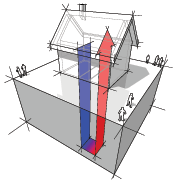How Does A Geothermal HVAC System Work?
Geology
The first thing you need to know about your home is the geology of the ground underneath it. If you are familiar with how geothermal heat-pump systems work, you know that they transfer heat to and from the ground by circulating water through buried loops of pipe. Your local geology helps determine how many feet of pipe are required, since the type of soil and the amount of rock present impacts how easily heat can transfer between the ground and the pipe. Geology can also determine whether it is easier to dig trenches for a horizontal loop system, or drill holes for a vertical loop system.
Available land space
The amount of yard space you have greatly impacts your geothermal installation options. A horizontal loop system requires more land area, and could cut through tree roots or landscaping. A vertical loop system, on the other hand, can fit in a very small space; the pipe can extend for hundreds of feet into the ground, while requiring a hole only a few inches across.
Water availability
If your home is located next to a body of water, or has a steady supply of clean groundwater, a couple of other geothermal installation options may be available to you. With a lake loop system, the loops can be submerged underwater instead of under the ground. And with an open loop system, the groundwater or lake water itself forms the loop; the heat pump draws water from the natural supply at one location, and returns the water to a different location a number of feet away.
To find out which geothermal installation options are available for your home, contact the Long Island heat pump experts at T.F. O’Brien Cooling & Heating. We’ll be happy to help.
Our goal is to help educate our customers about energy and home comfort issues (specific to HVAC systems). For more information about other HVAC topics, download our free Home Comfort Resource guide.
Geothermal image via Shutterstock

